Editor’s Note: This presentation was given by Michele Howard at GraphSummit 2022.

To start, we have Michele Howard from DXC Technology on their Career Navigator, a solution they’ve built on Neo4j’s Graph Database and Neo4j Graph Data Science, leveraging the concept of a knowledge graph.
For more information, please write me at daniel.ng@neo4j.com.
For the last ten years, I have worked for DXC Technology, a global IT services company, in a role that involves managing workforce planning, capability management, and making sure that our employees have the right skills to deliver our pipeline of work and grow their careers.
We want to create a world where an employee can sit down at a desk, press a button and get recommended career development pathways that are based on the roles and pathways that would be most valuable to the organization. This makes it simple for an employee to know how to up-skill and cross-skill based on available roles within our own organization, so they don’t have to leave DXC and find career development pathways elsewhere.
One of the most important challenges for any organization is having appropriately skilled people in the workforce. While this may sound easy enough, it is difficult to offer these career development opportunities in a large enterprise.
Organizational Challenges

As an organization with 130,000 people, we have disconnected systems. These systems and platforms are all doing what they’re intended to do, but they don’t all speak to each other and make it easy for our employees to use across different use cases. This leads to challenges around hiring and promoting from within and creating career pathways for employees. In times of high demand, we lose our employees to attrition, and in times of workforce reductions, we could have been more effective in redeploying our workforce.
Employee Challenges

Our employees are often confused by the complex ecosystem that we have. Employees want to know what pathways they should be taking to up-skill and cross-skill for the roles they aspire to. This means they need to know the in-demand skills within our organization so they know where to up-skill and can have career development discussions with their managers.
Manager Challenges
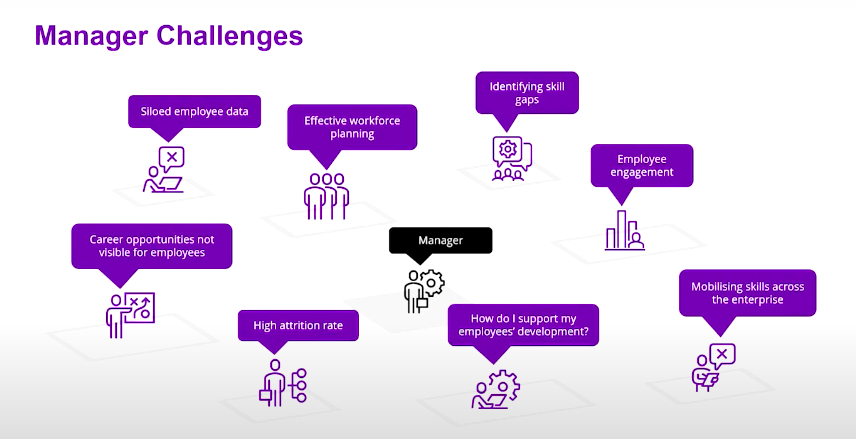
Our managers are required to support our employees with their development plans by looking to identify skill gaps within their teams and helping their employees with their aspirations; however, they don’t always have the data to actually provide the up-skilling and cross skilling advice their employees need. Managers are busy, so this development process is also an additional ask for them on top of their already busy day job.
DXC Career Navigator
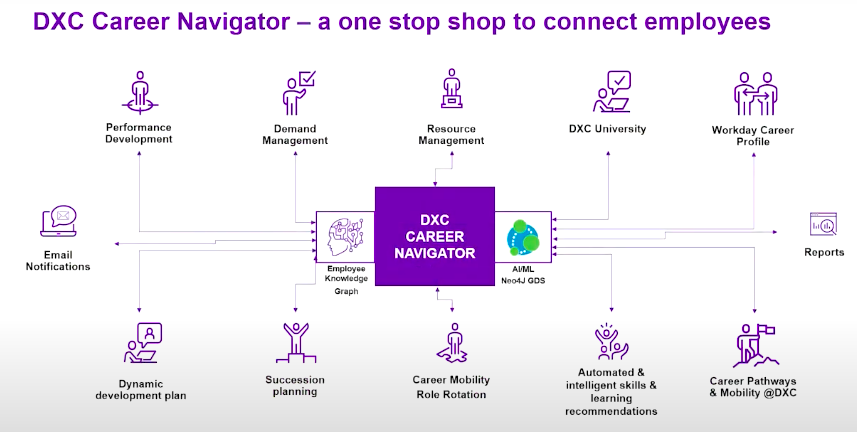
To address these organizational, employee, and managerial problems, we’ve created the DXC Career Navigator. It connects all of our siloed data and generates intelligent recommendations. We’ve taken siloed systems about employee performance development, demand management and resourcing, learning and development pathways, and Workday career profiles and combined them into a single framework that not only makes career pathway recommendations for our employees, but also keeps up with new technologies and skills employees need to have.
It’s crucial to address this disconnected career advancement data, as can be seen with the airline industry, for instance. Airline companies have lost some of their workforce and face the struggle of needing to quickly bring their workforces back to make sure planes fly on time and luggage gets delivered correctly.
Organizations don’t always carry a bench of employees anymore because that costs money.
So when they want to bring employees back or hire new people, it takes a long time to re-skill and up-skill them. The organization has lost all the knowledge their previous employees had and their new workforce has to be trained.
Our organization tracks our pipeline of demand and looks out six months’ time to say that demand is going to hit us in another six months. But for upskilling the workforce, six months is too late to be up-skilling employees. You need to be looking much further out to predict what’s going to hit in six months or a year and be able to have time to up-skill employees. By constantly upskilling employees, you can keep those employees working for you and not leaving to find outside pathways for career development.
Employee Recommendations: Dynamic Development Plan
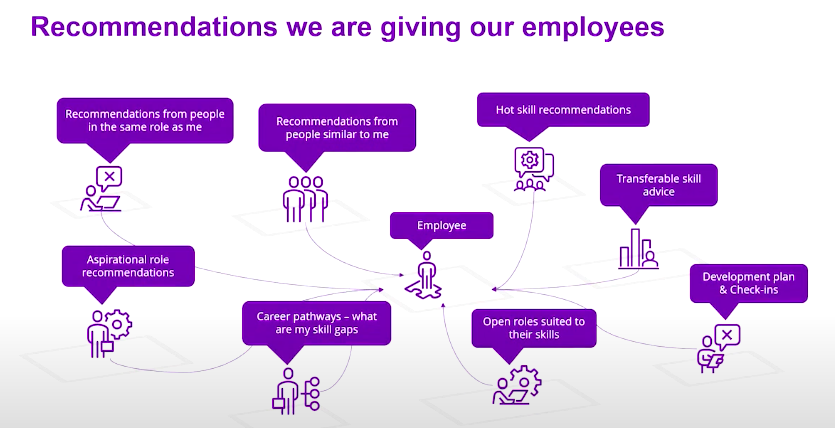
We’ve developed a front end for employees to create a dynamic development plan where their managers can support them. We bring all of the disconnected data together and make recommendations for employees, their managers, and other user types like resource managers, around learning and development to support our employees’ skilling.
We start by making recommendations based on skill progression recommendations made to similar employees. Essentially, we take the skills of our employees and compare them to their peers globally, and this gives recommendations on how they can up-skill and follow their development plan.
If employees want more information about the role they’re interested in, we provide more granular recommendations around that role. For example, if you’re a software engineer and you want to know the gaps between other software engineers with similar skills, the tool will tell you how you can meet those gaps and start to up-skill.
We look at transferable skills to see if employees have the base level of skills needed to upskill into new areas, like cybersecurity. This way we nudge our employees towards new career development pathways where we see high levels of demand.
This gives employees the opportunity to look at recommendations for new career pathways that they might not have thought about, and we can use career development to nudge them towards areas where our pipeline of demand is as a business, allowing them the opportunity to grow with the business.
During COVID, our organization had to pivot quickly because we started to see demand where we didn’t traditionally have demand before. The graph gives us the ability to pivot through disruptive events without having to rely on Excel spreadsheets or managers with only some knowledge of if this part of the business knows that these employees can be up-skilled.
Employee Knowledge Graph

We built an employee knowledge graph to connect all of these siloed data points and don’t even know at the moment how powerful this is going to become in six months’ time because we’ve just started with the really simple cases around transferable job roles. The next level is adding in data analytics to see all the complex relationships between our employee data and provide us with insights we never previously had for our entire organization.
How Are We Doing It?
We are using a combination of the graph database and the Neo4j Graph Data Science library with our algorithms. We are feeding data into the database and applying algorithms for our recommendations or to find similarly skilled people.
We’re currently enrolling 130,000 employees across our organization into our career navigator and have found that our clients and other businesses face the same problems as us. This tool has become something we can take to our clients to help them navigate the complex world of employee data and workforce analytics.
Front End: Human-Centered Design
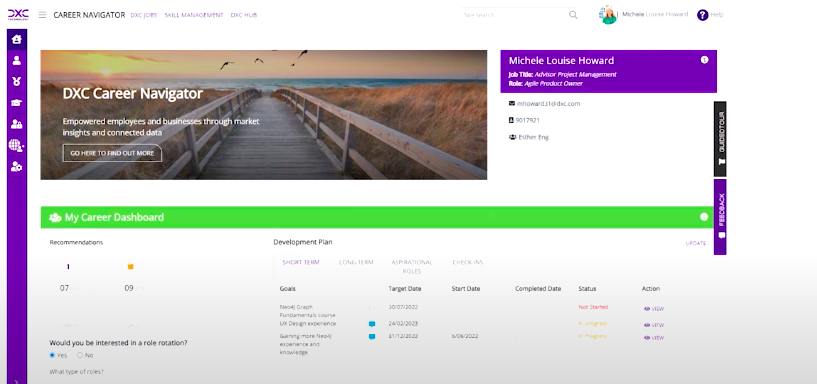
For the front end, we are creating a really intuitive user experience for our employees using human-centered design. This makes it easy for them to use and prompts them to add certain skills for a certain role. It will then give them prompts about when and how they should be up-skilling.
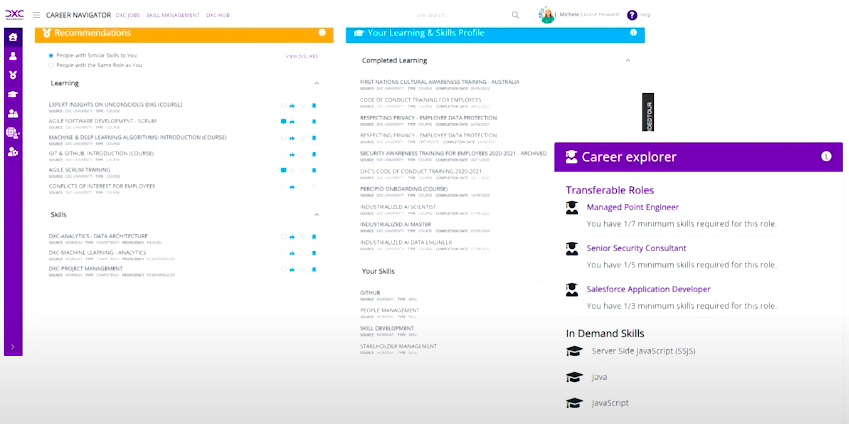
Here you can see the development plan where they have the ability to start planning out their short-term and long-term goals, while they are also receiving recommendations from the recommendation engine.
This starts to give employees nudges and prompts them to ask important career development questions:
Is this a tangible short-term goal for me or a long-term goal?
Is getting this skill as simple as taking a course or do I need to get some experience?
The Bottom Line
A lot of learning is experiential and upskilling may be about finding an opportunity with a project. This is why we included data on our project assignments, allowing managers to help their teams plan their development based on all the ways an employee can learn.
For us, the power of bringing together all of our data is giving employees really valuable recommendations for their career development. As an organization, we benefit from having our employees stay longer, moving to high demand opportunities and keeping their skill sets within DXC.



